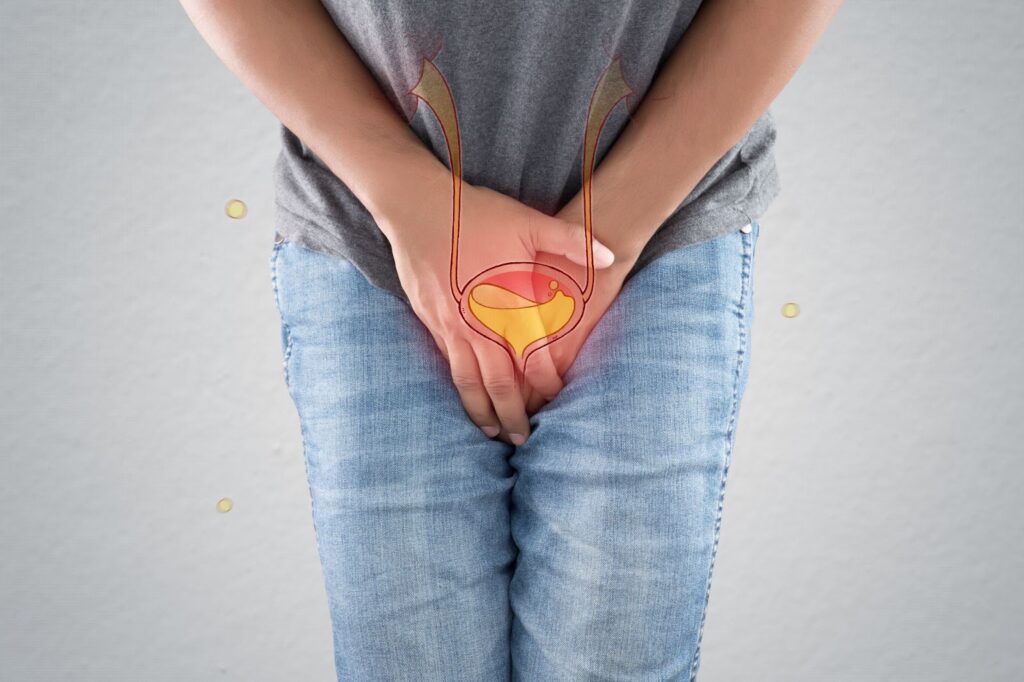Urinary tract infections (UTIs) and bladder infections are often used interchangeably to describe an infection in the urinary tract system. They are not, however, the same thing. While both illnesses can cause similar symptoms, the primary distinction is the location of the infection in the urinary system.
In this article, we’ll define them separately to clearly distinguish the difference between UTI and a bladder infection.
What is UTI?
A urinary tract infection (UTI) is a typical bacterial infection that affects the urinary system, which includes the kidneys, bladder, ureters, and urethra. UTIs happen more to women than men and can cause discomfort and pain. To properly diagnose and treat UTIs, it is critical to understand their causes, symptoms, and potential complications.
What are the cause and risk factors?
UTIs are caused by bacteria, with the most common type being Escherichia coli (E. coli), which can enter the urinary tract through the urethra and cause an infection. Other types of bacteria can also cause UTIs.
Unfortunately, there are some people who are more likely than others to develop a UTI. For example, females are more prone to UTIs because their urethras are shorter and closer to the rectum. This allows germs to enter the urinary system more easily.
Other factors that can raise the risk of UTIs include:
- A previous UTI
- Sexual behavior
- Changes in the microorganisms that dwell in the vagina are often known as vaginal flora. For example, menopause or the use of spermicides might produce these bacterial alterations.
- Pregnancy
- Age (older persons and children are more prone to UTIs)
- Urinary tract structural issues, such as an enlarged prostate
- Poor hygiene, for example, children who are still potty-training
What are the symptoms of a UTI?
The symptoms of a UTI are not the same for everyone. It can vary depending on the areas of the urinary tract that is affected. However, common symptoms of a UTI include a frequent urge to urinate, pain or burning sensation during urination, cloudy or strong-smelling urine, pain or pressure in the lower abdomen or back, fatigue, or fever. A UTI can cause nausea, vomiting, and back pain in severe cases.
Complications of untreated UTIs
Untreated urinary tract infections (UTIs) can cause major implications such as kidney infections, sepsis, and irreversible kidney damage. Pregnant women with UTIs are also likely to have low birth weight or preterm kids. UTIs can also induce scarring and narrowing of the urethra, which can lead to urinary tract blockages, which can be fatal.
What is a bladder infection?
A bladder infection, commonly known as cystitis, is a form of urinary tract infection that affects the bladder particularly. Bacteria entering the bladder via the urethra can cause it. Bladder infections can be painful and inconvenient but are typically curable with medicines.
UTI vs. Bladder Infection
A bladder infection is a type of UTI, as the infection is specifically located in the bladder. However, not all UTIs are bladder infections. UTIs can also affect other parts of the urinary system, such as the kidneys or urethra. While bladder infections are typically less severe than other types of UTIs, they can still lead to complications if left untreated.
What are the causes and risk factors specific to bladder infections?
Bladder infections are most commonly caused by E. coli bacteria, which can enter the bladder through the urethra. Other bacteria that might cause bladder infections include Staphylococcus saprophyticus.
Risk factors for bladder infections include:
- Being female
- Sexual activity
- Some methods of birth control
- Menopause
- Urinary catheterization
- Urinary tract abnormalities
- Not drinking enough water
What are the symptoms of a bladder infection?
The symptoms of a bladder infection manifest pain or discomfort in the lower abdomen or pelvic region, pain or burning sensation during urination, frequent and urgent need to urinate, cloudy or strong-smelling urine, blood in the urine, and fever or chills. These symptoms can vary in severity, and not everyone with a bladder infection will experience all of them.
Differentiating UTI and Bladder Infection
This section will end the confusing battle between bladder infection vs. UTI. Two distinct medical conditions require different treatment approaches. While both conditions affect the urinary system, UTIs can affect any part of the urinary tract, while bladder infections specifically affect the bladder.
Therefore, understanding the differences between UTIs and bladder infections can help with proper diagnosis and treatment.
Medical distinctions
The site of the infection differs between UTIs and bladder infections. Urinary tract infections (UTIs) can affect the bladder, urethra, ureters, and kidneys, whereas bladder infections only affect the bladder. UTIs are often more harmful than bladder infections and may result in more severe consequences, such as kidney infections.
How UTI and Bladder Infection Are Diagnosed
UTIs and bladder infections are diagnosed through physical examination, medical history, and urine tests. A couple of medical tests can diagnose UTIs and bladder infections.
It’s important to consult a healthcare professional for an accurate diagnosis and appropriate treatment. The specific diagnostic approach may vary based on individual circumstances and healthcare provider preferences.
Medical Tests Used to Determine the Presence of Each Condition
To determine the presence of a urinary tract infection (UTI) or bladder infection, healthcare professionals typically employ a combination of medical tests. The specific tests used may vary based on the patient’s symptoms, medical history, and clinical judgment.
Here are some common tests used for diagnosing UTIs and bladder infections:
- Urinalysis: This is one of the primary tests used to diagnose UTIs and bladder infections.
- Urine culture: In this test, a urine sample is cultured in a laboratory to identify the specific bacteria causing the infection.
- Antibiotic sensitivity testing: After identifying the bacteria through urine culture, antibiotic sensitivity testing is performed to determine which antibiotics are most effective in treating the infection.
- Imaging tests: In some cases, imaging tests such as ultrasound, CT scan, or MRI may be performed to evaluate the urinary tract and detect any abnormalities, such as kidney stones or structural abnormalities, that could contribute to recurrent infections.
- Cystoscopy: Cystoscopy involves the insertion of a thin tube with a camera (cystoscope) into the urethra and bladder.
Symptoms and their variations
Although the symptoms of UTIs and bladder infections may overlap, each illness may have its own symptoms. Both infections can induce urine pain or discomfort, but UTIs can also cause fever, nausea, and back pain. Bladder infections can cause pelvic discomfort, blood in the urine, and an urgent desire to pee.
Overlapping Symptoms of UTI and Bladder Infection
Urinary tract infections (UTIs) and bladder infections share many overlapping symptoms because the bladder is a common site of infection in UTIs.
The symptoms of both conditions can include:
- Frequent urination: Feeling the need to urinate more often than usual, even if only small amounts of urine are passed.
- Urgency: A strong and sudden urge to urinate that is difficult to postpone.
- Pain or discomfort during urination: A burning sensation or pain while urinating.
- Lower abdominal or pelvic pain: Pain or discomfort in the lower abdomen or pelvis.
- Cloudy or bloody urine: The urine may appear cloudy, and in some cases, it may have a pinkish or reddish color due to the presence of blood.
- Foul-smelling urine: Urine may have a strong, unpleasant odor.
- Incomplete emptying of the bladder: Feeling like the bladder is not fully empty even after urinating.
- General malaise: A sense of fatigue, weakness, or overall feeling of illness.
Unique Symptoms Associated with Each Condition
While UTIs and bladder infections share many overlapping symptoms, there are also some unique symptoms associated with each condition.
Here are some of the unique symptoms that may help differentiate between the two:
Unique Symptoms of UTIs
- Flank pain: Pain in the sides of the lower back, specifically around the area of the kidneys. This pain may indicate an upper urinary tract infection involving the kidneys (pyelonephritis).
- Fever and chills: In more severe cases of UTIs, especially if the infection has spread to the kidneys, patients may experience fever and chills along with other symptoms.
- Nausea and vomiting: Severe UTIs can cause nausea and vomiting in some cases.
- Back pain: Pain in the lower back, specifically in the kidney area, can be a symptom of a kidney infection associated with a UTI.
Unique Symptoms of Bladder Infections
- Pelvic pressure: A sensation of pressure or heaviness in the pelvic region, which may be more specific to bladder infections.
- Suprapubic pain: Pain or discomfort in the lower abdomen, specifically above the pubic bone.
- Urinary incontinence: Unintentional leakage of urine, particularly when coughing, sneezing, or exerting pressure on the bladder.
- Painful sexual intercourse: Some individuals with bladder infections may experience pain or discomfort during sexual intercourse.
Treatment approaches
For the bladder infection vs. UTI treatment, urinary tract infections (UTIs) and bladder infections are typically treated with antibiotics to clear the infection. However, treatment approaches may vary depending on the severity and location of the infection. In addition to antibiotics, some home remedies and lifestyle changes may help alleviate symptoms and prevent future infections.
Common Treatments for UTI
UTIs are typically treated with antibiotics to clear the infection. The antibiotic that the doctor will prescribe will depend on the type of bacteria causing the infection. Drinking plenty of water because urinating can also help flush out bacteria.
Specific Treatments for Bladder Infections
Antibiotics are also used to treat bladder infections. Because the infection is specific to the bladder, treatment may be quicker than for UTIs. In certain circumstances, bladder infections can require further medical treatment, such as bladder catheterization to clear the bladder.
Preventive measures for UTI and bladder infection
Simple lifestyle adjustments and hygiene habits can help avoid urinary tract infections (UTIs) and bladder infections. Here are some precautions you may take to lower your chance of having UTIs and bladder infections:
- Drink plenty of water and stay hydrated.
- Urinate frequently, and don’t hold urine for too long.
- After using the restroom, wipe from front to back.
- Avoid using irritating feminine products and deodorant sprays.
- Use condoms during sexual intercourse.
- Practice good hygiene, including washing the genital area before and after sex.
- Avoid wearing tight-fitting clothes, especially pants, and underwear.
- Take showers instead of baths.
- Avoid using hot tubs and bubble baths.
Can a bladder infection lead to a UTI?
A bladder infection may spread to the kidneys and create a more serious UTI if left untreated. Therefore, it is important to seek urgent care if you suspect you have a bladder infection or UTI.
Are there any natural remedies for UTI and bladder infection?
Some natural remedies may help alleviate symptoms of UTIs and bladder infections. However, it is important to note that natural remedies should not replace medical treatment. Here are some natural ways that you may do at home:
- Drink cranberry juice or take cranberry supplements.
- Take probiotics to promote healthy bacteria in the urinary tract.
- Drink green tea, or you can also consume green tea supplements.
- Apply heat to the pelvic area to reduce pain and discomfort.
- Take vitamin C supplements because they will help boost the immune system.
What is the impact of gender on the likelihood of developing UTI or bladder infection?
Gender has a significant impact on the likelihood of developing urinary tract infections (UTIs) and bladder infections, with women being more prone to these infections compared to men. This increased susceptibility can be attributed to anatomical differences.
Women have a shorter urethra compared to men, which provides a shorter distance for bacteria to travel from the external genital area to the bladder, increasing the risk of infection. The closer proximity of the urethral opening to the anus in women also facilitates the transfer of bacteria from the gastrointestinal tract to the urinary tract, further elevating the risk.
While men are less susceptible to UTIs and bladder infections, they can still be affected, particularly in older age or in the presence of certain medical conditions. However, the overall risk for men remains lower compared to women due to differences in anatomy and hormonal influences.
When should you see a doctor?
Suppose you have signs of a UTI or bladder infection, such as discomfort or burning while urinating frequent urination, or pelvic pain. In that case, you should immediately seek urgent care for bladder infection and UTI. UTIs and bladder infections, if left untreated, can progress to more serious consequences, such as kidney infections.
UTI vs. Bladder Infection: Take Them Seriously
To summarize, while bladder infections are a subset of UTIs, not all UTIs are bladder infections. Understanding the distinction between the two can help you properly detect and treat them.
It’s also critical to practice excellent hygiene and drink lots of water to avoid UTIs and bladder infections in the first place.
But if you’re already experiencing the symptoms, proceed to Aether Health – SilverLake ER for immediate medical treatment.











